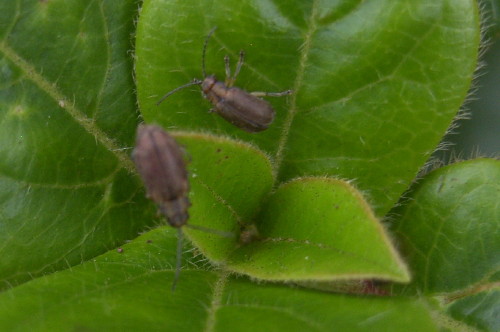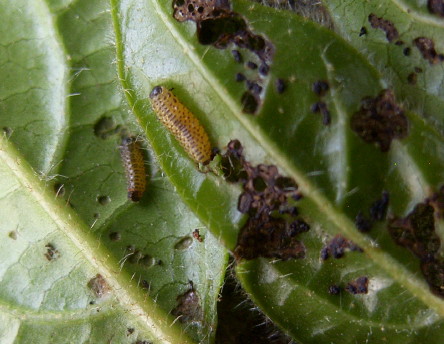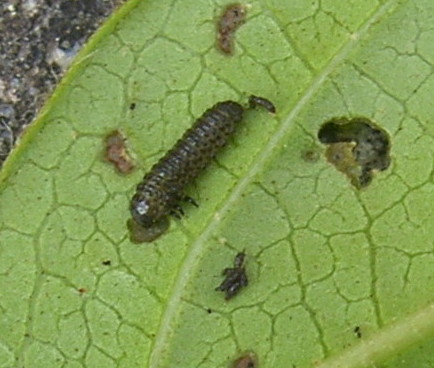Viburnum Beetle
Scientific name: Pyrrhalta viburni
 Adult Viburnum beetles |  A Viburnum tinus shrub infested with Viburnum Beetle larvae |
Viburnum Beetles and their larvae feed on the leaves of Viburnum species including V. tinus, V. opulus, and V. lantana. They make holes in the leaves, sometimes reducing them to a lacework of the veins and the brown residue can have a foul smell, particularly when wet. Most damage is caused by the larvae.

The larvae are creamy yellow/ green with darker markings hatching in late spring, feeding from April to June as they develop through several instars reaching about 8mm long before crawling down to the soil where they pupate.
The greyish brown adult beetles are about 4.5 to 6mm long emerging in the summer, also feeding on the foliage before mating in the late summer. The females lay up to 500 eggs on Viburnum twigs by chewing small holes the size of a pinhead in the bark with about 8 eggs per hole which they cap with chewed bark and excrement - this expands to hold moisture preventing the eggs from drying out. These 'nests' are usually in rows on the underside of current year growths They overwinter to hatch the following spring. Laying eggs can continue until the first frosts kill the adults in October. The cycle from egg hatching to emerging adults takes eight to ten weeks.

Early instar larva feeding on underside of a leaf.
The first larvae feed on the underside of the young leaves. There are three instars of larvae which shed their cuticle as they expand to the next one, later instars chew through the full depth of the leaf. The final instar is 10 to 11mm long and this one crawls down to the soil to pupate. The pupae are difficult to find and require moist soil, but if it is too wet or dry they can perish.
Check plants for signs of the egg laying by looking at the undersides of previous year's growth - the rows of raised bumps. In spring as the eggs start to hatch the first larvae will attack the young foliage. Usually it is not possible to pick them off so this is the best time to spray with a systemic agent repeated a few times at two week intervals. Later than this the damage will be more extensive and the adults are less susceptible to treatments.
Disturbing the soil near to previously affected shrubs in winter may expose the pupae to ground-feeding birds and the weather, so reducing the population.
Back to GARDEN CREATURES